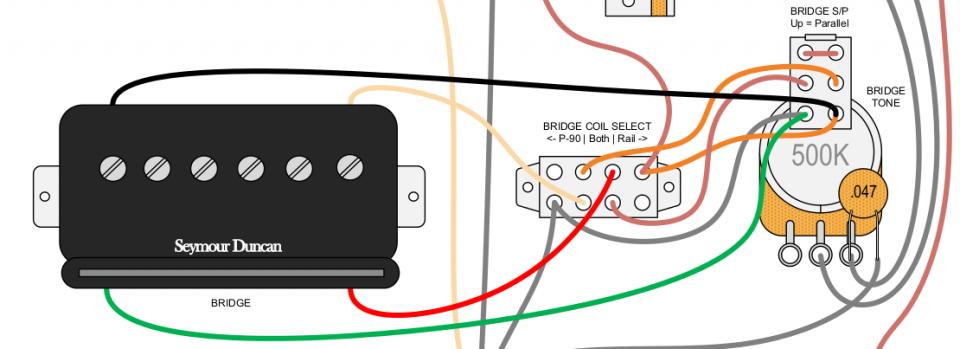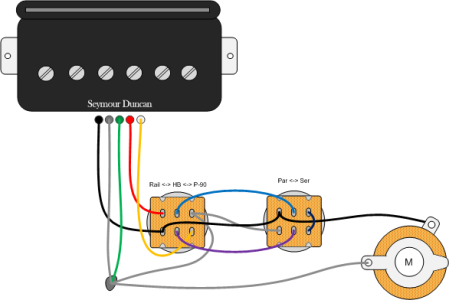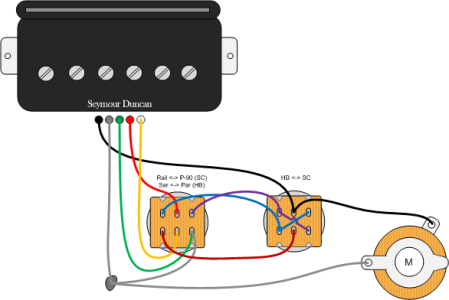Liko
New member
I've been looking for a way to simplify this rat's nest:

This is a two-switch scheme to control a P-rail pickup, but unlike the Triple Shot system, it separates coil selection from series-parallel switching so the resulting control set is more intuitive (no more having to memorize what having one down and one up or VV means). It works in every permutation of switch position - I've traced it several times - but it uses a fairly large Mustang switch (this is going in a Strat pickguard that will have all the other standard controls, so trying to cram two of these between the 5-way and volume pot will be a squeeze), and the wiring, as you can see, is a nightmare.
So, I've gone back to the drawing board. I rationalized that the switches only need to change the connections on red and white wires; the black wire can always go to hot and the green can always be grounded, as long as the single-coil modes open the other half of the unwanted coil. So, a simple routing chart shakes out:
Mode Red White
-------------------------------------------
Rail Hot Open
Ser White Red
Par Hot Ground
P90 Open Ground
A simple enough goal. After a little messing around, I came up with this design based on two mini-toggles (simplified to emphasize the switching for one pickup):

The left switch is a 3-way on-on-on, "Type 1" (middle position throws the bottom pole to the right, top pole left), the right switch is a simple on-on. Wiring is SD color-code for the pickup (red-green is rail, black-white is P-90), grey and green are always grounded, black is always hot, other wires colored for easy ID. Overall, this is a bit simpler and easier to trace, and it uses smaller switches that I only need a drill to make the hole for, instead of also needing a scroll saw and a lot of patience.
However, there's a glitch. In either of the single-coil modes, selecting parallel mode shorts hot to ground, cutting the pickup out entirely. In rail mode it happens through the purple wire (it has a ground connection through the lower left of the S/P switch which goes to the black lead at the lower left of the coil select), while in P-90 mode the culprit is the blue wire (which gets connected to ground on the coil select on the upper right, and to hot on the upper left of the S/P switch).
If I remove the black and grey leads between the two switches (moving the actual pickup lead and ground connection to the appropriate S/P terminals), parallel mode no longer kills the pickup in single-coil modes; series mode does, by cutting the hot side in Rail coil mode (the purple lead no longer has that black lead) and the ground side in P-90 mode (the long path through the series circuit dead-ends where the grey lead used to be). In an imperfect world, I think I'd prefer this to the first option, because I'm pretty sure my preferred humbucking mode will be parallel for lower output, so I can leave it there and coil-select as I please without worrying about killing the pickup. Also, no hot or ground connections on the coil selector means either type of on-on-on toggle will do.
All that said, can anyone think of a way to "fix" the bottom image to allow single-coil operation regardless of the series/parallel option, without adding more hardware?
This is a two-switch scheme to control a P-rail pickup, but unlike the Triple Shot system, it separates coil selection from series-parallel switching so the resulting control set is more intuitive (no more having to memorize what having one down and one up or VV means). It works in every permutation of switch position - I've traced it several times - but it uses a fairly large Mustang switch (this is going in a Strat pickguard that will have all the other standard controls, so trying to cram two of these between the 5-way and volume pot will be a squeeze), and the wiring, as you can see, is a nightmare.
So, I've gone back to the drawing board. I rationalized that the switches only need to change the connections on red and white wires; the black wire can always go to hot and the green can always be grounded, as long as the single-coil modes open the other half of the unwanted coil. So, a simple routing chart shakes out:
Mode Red White
-------------------------------------------
Rail Hot Open
Ser White Red
Par Hot Ground
P90 Open Ground
A simple enough goal. After a little messing around, I came up with this design based on two mini-toggles (simplified to emphasize the switching for one pickup):

The left switch is a 3-way on-on-on, "Type 1" (middle position throws the bottom pole to the right, top pole left), the right switch is a simple on-on. Wiring is SD color-code for the pickup (red-green is rail, black-white is P-90), grey and green are always grounded, black is always hot, other wires colored for easy ID. Overall, this is a bit simpler and easier to trace, and it uses smaller switches that I only need a drill to make the hole for, instead of also needing a scroll saw and a lot of patience.
However, there's a glitch. In either of the single-coil modes, selecting parallel mode shorts hot to ground, cutting the pickup out entirely. In rail mode it happens through the purple wire (it has a ground connection through the lower left of the S/P switch which goes to the black lead at the lower left of the coil select), while in P-90 mode the culprit is the blue wire (which gets connected to ground on the coil select on the upper right, and to hot on the upper left of the S/P switch).
If I remove the black and grey leads between the two switches (moving the actual pickup lead and ground connection to the appropriate S/P terminals), parallel mode no longer kills the pickup in single-coil modes; series mode does, by cutting the hot side in Rail coil mode (the purple lead no longer has that black lead) and the ground side in P-90 mode (the long path through the series circuit dead-ends where the grey lead used to be). In an imperfect world, I think I'd prefer this to the first option, because I'm pretty sure my preferred humbucking mode will be parallel for lower output, so I can leave it there and coil-select as I please without worrying about killing the pickup. Also, no hot or ground connections on the coil selector means either type of on-on-on toggle will do.
All that said, can anyone think of a way to "fix" the bottom image to allow single-coil operation regardless of the series/parallel option, without adding more hardware?
Last edited:

